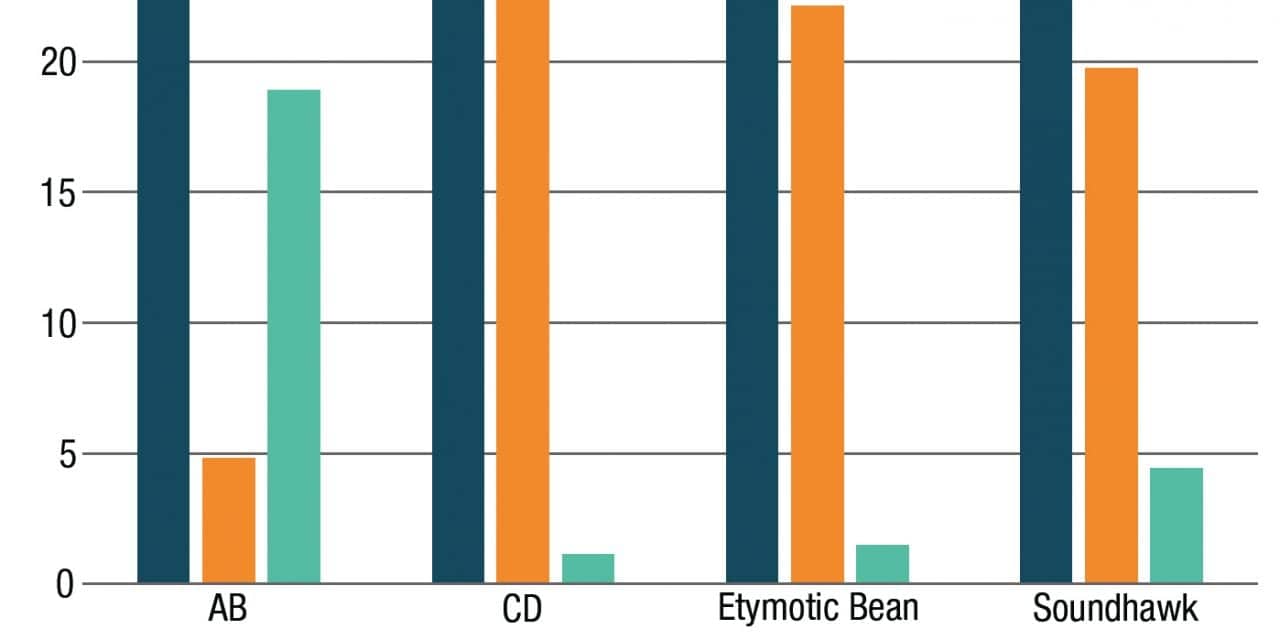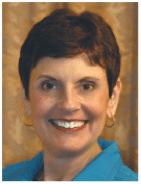Research | December 2018 Hearing Review
Six case studies replicating previous research – but using people with moderate hearing losses
OTC hearing devices are coming, but how should they function and for whom should they be recommended? In particular, two recent studies (Humes et al and Reed et al) have been very influential in shaping the dialog on this issue. However, as this article points out, these two studies may have focused primarily on subjects with mild or near-normal hearing loss. Six case studies replicating the Humes et al study methods are presented here, with the results showing that people with moderate hearing loss (41-55 dB PTA) may be better served by what Humes et al characterized as an “audiology best practices” model and may be unlikely to find success with a consumer-driven model of care.
Numerous healthcare professionals, lawmakers, physicians, attorneys, laypeople, and hearing care professionals have espoused the benefits of over-the-counter (OTC) hearing aid sales and consumer self-diagnosis and self-treatment of hearing loss. Researcher Frank Lin, MD,1,2 the President’s Council of Advisors on Science and Technology (PCAST),3,4 the National Academies of Sciences, Engineering, and Medicine (NASEM),5,6 the Hearing Loss Association of America,7 and the Academy of Doctors of Audiology (ADA)8,9 endorse the need for an OTC amplification option. Clearly, consumer-based methodologies offer more convenient access to hearing healthcare and greater affordability relative to the current hearing aid distribution system. For these reasons, such a system is attractive to many healthcare professionals and consumers alike.
Additionally, two noteworthy 2017 studies published by Humes et al10,11 and Reed et al12 have suggested that such consumer-based methodologies result in outcomes similar to those obtained with today’s hearing aids fit by audiologists for adults with mild-to-moderate hearing loss. With this seeming support for consumer-based methodologies, the Warren Grassley Over-the-Counter (OTC) Hearing Aid bill has been signed into law (PL 115-52).13,14 This bill allows OTC purchase without medical or audiological involvement, and is supported by consumers, Congress, and many healthcare professionals. As part of this consumer-based hearing aid initiative, the US Food and Drug Administration (FDA) reported in December 2016 it will no longer enforce medical evaluation or medical waiver for adults seeking amplification.15 Thus, with these changes, the debate has evolved from “if” OTC hearing devices should exist to “how” they should function and “for whom” the devices should be recommended.
The work of Lin and colleagues16-19 showing the possible links between hearing loss and dementia, increased rate of hospitalization, increased risk of falls, accelerated brain shrinkage, and depression puts hearing loss in a “more than an inconvenience” medical risk category. The subsequent work of Sharma and her colleagues20-24 suggests brain resource reallocation results from untreated and improperly treated hearing loss which makes real-ear verified aided audibility highly desirable, if not medically appropriate.
Humes et al10 evaluated the efficacy of an OTC service delivery model using state-of-the-art hearing aids configured by three delivery methods: 1) An Audiology Best Practices (AB) model; 2) A Consumer-Decides (CD) model; and 3) A Placebo group. In this study, 153 subjects (ages 55 to 79 years) were randomly assigned to one of these three groups. The AB group received medical evaluation and cognitive screening, comprehensive audiological services, and hearing aid fitting and counseling (but not post-fitting adjustment and counseling).25,26 In the AB condition, all subjects received premium-level hearing aids fit to an NAL NL-2 target. The placebo group also received comprehensive audiological evaluation, medical evaluation and cognitive screening, and wore the same premium-level hearing aids with transparent coupler gain. The CD group used the same premium-level hearing aids pre-programmed to 1 of 3 audiograms, reflecting hearing losses similar to their own after comprehensive audiological evaluation, medical evaluation, and cognitive screening.
Humes et al report the CD model produced word recognition and user satisfaction results comparable to the AB model, with several caveats regarding the benefit of AB service delivery for both the CD and Placebo groups. One caveat was the hearing loss being studied. Table 1 in Humes et al10 provides the average PTA expressed in dB HL. Specifically, the average PTA for all three AB, CD, and Placebo groups ranged from 27 to 29 dB HL, with a standard deviation between 7.7 to 8.6 dB, indicating a mild degree of hearing loss for the majority of subjects in this study group.
Recalling that a moderate hearing loss by Clark’s classification scheme27 puts a moderate hearing loss between 41-55 dB PTA, it is clear the majority of these subjects could not have had moderate hearing loss. Taking these data one step further, it is instructive to see how many of the 154 subjects could have had moderate hearing loss and still yield the average PTA noted in the Humes et al data. For example, assuming all but 4 participants had an average bilateral PTA of 28 dB and the other 4 had bilateral 55 dB PTAs, the following computation ensues:
300 ears x 28 dB = 8400
+ 8 ears x 55 dB = 440
Combined together = 8840
Divided by the 308 ears in this study yields a group average PTA of 29.7 ? 28 dB reported average.
If 25 subjects had bilateral 50 dB PTAs and the other 129 had bilateral PTAs of 28 dB
258 ears x 28 dB = 7224
+ 50 ears x 50 dB = 2500
Combined together = 9724
Divided by the 308 ears in this study yields a group average PTA of 31.6 ? 28 dB reported average.
If 30 subjects had 45 dB PTAs and the other 124 had 28 dB PTAs
248 ears x 28 dB = 6944
+ 60 ears x 45 dB = 2700
Combined together = 9644
Divided by the 308 ears in this study yields a group average PTA of 31.3 ? 28 dB reported average.
These calculations show that in the Humes study10 there could not have been even 30 subjects of the 154 (<20%) with bilateral PTAs of 45 dB or greater, assuming all others had PTAs within test-retest levels of borderline normal hearing (28 dB). As such, any statements regarding these 154 subjects should be interpreted as largely representing people with near borderline normal hearing.
Further, the amount of improvement in word recognition in noise noted in this study is small relative to the unaided results. Specifically, the average difference among the unaided versus aided scores on the Connected Speech Test (CST) expressed in randomized arcsine units (RAU) is small in the Consumer Decides and Audiology Best practice subjects. These reported differences are in the range of 18 to 27 points RAU.
Humes et al10 report that the presentation level in both aided and unaided conditions was 65 dB SPL at a +3 dB signal-to-noise ratio. In a calibrated sound field, 65 dB sound pressure level (SPL) translates to 53 dB HL. Thus, anyone with a bilateral 55 dB PTA would score 0% on the CST speech test materials in the unaided condition when presented at 65 dB SPL. A person with a bilateral 50 dB PTA would do only slightly better under the same unaided test conditions.
To improve the binaurally aided score for a person with either a bilateral 50 or 55 dB PTA by 18 to 27 points on the CST would still leave the subject nonfunctional in most noisy conditions. These minimal improvements on the CST offer further evidence there were few subjects with moderate hearing losses represented in this study.
In a similar study, Reed et al12 reported that outcomes for 42 adults with mild-to-moderate hearing loss using selected personal sound amplifying products (PSAPs) and a contemporary $2,500 hearing aid (Oticon Nera) were similar as measured by the AzBio sentence recognition test in noise.28 In that study, the four-frequency average hearing level was 37.5 dB HL at 500, 1000, 2000, and 4000 Hz. However, standard deviations were not provided, precluding a more in-depth understanding of the number of subjects who might exhibit a more moderate hearing loss. In addition, the authors reported unaided word recognition scores on the AzBio test presented at 35 dB HL to range from 72.7% to 80.3% correct. Such scores could not be achieved by persons with a moderate hearing loss, as the sentence presentation level would be at least 5 dB or more below the individual’s pure-tone average.
In short, the two prominent published studies to date appear to have shown that—for the listener with a mild hearing loss—there is little measurable difference in delivery method or technology used, assuming the audibility provided is acceptable (and, in the case of Humes et al,10 the participants received comprehensive audiological and medical evaluation and psychological screening).
To establish clarity and improve policy relative to the distribution of PSAP/CD-type hearing aids, six case studies are presented here. These cases manifest bilaterally symmetrical moderate hearing losses—not mild hearing losses as in previous studies—which is a significant difference when considering the OTC/PSAP options.
Subjects of Replication Study
The current series of case studies depicts six subjects comprised of highly educated adults aged 47 to 70 years of age. Hearing aid experience ranged from 0 to 25 years. This group was comprised of three engineers, one PhD, one MD, and one rehabilitation counselor. English was the native language of all subjects, and all had bilaterally symmetrical moderate hearing losses.
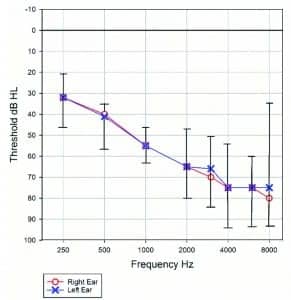
Figure 1. [Click on images to enlarge.] Average air conduction thresholds from the six participants in this study. Ranges are shown by error bars.
Overview of Design
This series of case studies is presented in the manner of a single-subject design. Each individual received three randomized fittings, while blinded to intent: audiology best practices (AB) service delivery; consumer-decides (CD) service delivery; and PSAP delivery. The following amplification was used in the study:
- ReSound Alera 961 receiver-in-the-canal (RIC) hearing aids having 17 log10-frequency-based (warp) compression bands with 9 gain handles and 4 programs available (ie, same as Humes10) for both the CD and AB methods.
- Soundhawk PSAP, programmed to maximum output in both the low- and high-frequency regions with an iPhone 7 using the software application provided by Soundhawk.
- The Etymotic BEAN PSAP, which is non-programmable.
Markings on all devices were hidden from the subjects, and the devices were placed on the subjects’ ear without allowing the subject visualization of the tested device.
Methods
An unaided evaluation consisted of otoscopic examination of both ears, a complete audiological assessment, and a detailed case history. Following otoscopy, the audiological assessment began with 226-Hz tympanometry and automated ipsilateral pure-tone acoustic reflex threshold measurement at 500, 1000, 2000, and 4000 Hz using a Grason-Stadler Inc (GSI) Model 38 immittance device. Air-conduction pure-tone audiometry followed, using a calibrated GSI 61 audiometer with Etymotic Research ER-3A insert earphones, at octave intervals from 250-8000 Hz, plus 3000 and 6000 Hz. Tests included: (a) Speech reception thresholds (SRT) for Central Institute for the Deaf (CID) W-1 spondaic words29 using recorded voice and 5-dB ascending step size; (b) Word recognition scores for recorded Maryland CNC monosyllabic words30 presented at 40 dB above SRT; (c) Loudness discomfort level (LDL) measured for pure tones under earphones at 250, 500, 1000, 2000, 3000, and 4000 Hz using the instructions and 7-point scale from Cox et al31; (d) Olsen-Noffsinger tone decay at 2000 Hz bilaterally32 and (e) Bone-conduction hearing thresholds at octave intervals from 250 Hz through 4000 Hz. All PSAP devices were set to maximum output where such choice was available. The Resound Alera hearing aids in the CD condition were programmed according to the most impaired audiogram noted by Humes et al.
The same model ReSound Alera 961 hearing aid reported in the Humes et al study was used both for the AB and CD pre-programming. The default programming options for the CD measures were also the same as used by Humes: Fitting-experienced nonlinear; Binaural Correction-off; Fixed Directional; Directional Mix-very low; Digital Feedback Suppression (DFS)-moderate; Expansion-off; Noise Tracker II-per environment; Wind Guard-off; Environmental Optimizer-0 dB; Tinnitus Sound Generator-off. ReSound’s Aventa programming software (Version 3.10.0.83) was used to pre-program the hearing aids in the AB and CD conditions to generate target gain prescriptions using the common NAL-NL233 formula to compensate for the participant’s hearing loss. This pre-program was then modified for the AB group to meet the NAL-NL2 target guided by real-ear aided responses as described below.
The Soundhawk and the Etymotic BEAN used in the Reed et al study12 were used for the PSAP condition. The Soundhawk PSAP was pre-programmed to maximum output in both the low- and high-frequency regions with an iPhone 7 using the software application provided by Soundhawk. No pre-programming was possible with the Etymotic Bean in the PSAP condition.
For all conditions (AB, CD, and PSAP), the output of the hearing aids was assessed via real-ear measurements using an Audioscan Verifit system (Model VF-1; software v3.12.1). In the AB condition, all subjects were fit to a real-ear verified NAL-NL2 target, ±5 dB from 250 to 4000 Hz, for 50, 60, or 75 dB SPL inputs as prescribed by NAL using the “carrot passage” stimulus. For the PSAP, AB, and CD conditions, real-ear measurements took place with the subject and the audiologist located in a single sound-treated therapy room.
All subjects were tested using the Quick Speech-in-Noise (QuickSIN) test materials of Killion and colleagues34 presented in a calibrated sound booth at 50 dB HL (62 dB sound pressure level at the center of the subject’s head placement). Only equivalent word lists were used35 with one practice list provided prior to data gathering. The order of devices was randomized, and the following scores were obtained:
- Sound-field unaided scores;
- Unilaterally fit Etymotic BEAN on the better ear, as per Reed et al12;
- Unilaterally fit Soundhawk set to maximum amplification on the better ear;
- Bilateral ReSound Alera 961 fittings set to the greatest of three hearing loss programs used by Humes et al10 for the Consumer Decides model;
- Bilateral ReSound Alera 961 set to a real-ear verified NAL-NL2 target for 50, 60, and 75 dB SPL inputs.
Results

Table 1. Demographics and data for various measures from the six individuals. Note: PTA = pure-tone average; HFPTA = high-frequency pure-tone average; LDL = loudness discomfort level; SRT = speech reception threshold; WRS-Q = word-recognition score in quiet; QuickSIN = Quick Speech-in-Noise Test.
Table 1 presents demographic and averaged audiological data from these six participants. As with the subjects of Humes et al,10 the levels of income, age, and education level are similar. What is notably different about these subjects from those of Humes et al is that, on average, their pure-tone averages (PTAs) are 24 dB poorer. Specifically, the six cases shown here present with mean PTAs of 52 dB HL (in the moderate hearing loss range) while those of Humes et al subjects show 28 dB HL PTAs (within test-retest reliability of borderline normal hearing).
Table 2. [Click on image to enlarge.] Average QuickSIN values (SNR loss) for all individuals with standard deviations. Lower median scores indicate better results.
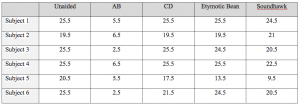
Table 3. Raw data showing QuickSIN scores (SNR loss) for each subject. Lower scores indicate better results.
Tables 2-3 show the average speech scores for the QuickSIN for all four test conditions. From these data it is apparent these six cases show average QuickSIN scores approximately 15 dB better than any PSAP or CD condition.
Figure 2 shows the average unaided (dark blue), aided (orange), and relative benefit (light blue) scores for the QuickSIN for these six cases (ie, means for the QuickSIN measure for the six individuals). Unaided and aided QuickSIN scores are provided, as well as the difference between these two scores, expressed as QuickSIN benefit. It is apparent that the Audiology Best (AB) practice programming resulted in an improved SNR loss—5 dB on average, to 19 dB or more loss for all other amplification configurations. For the CD and Bean (PSAP#2) conditions, the benefit of the unaided versus aided SII condition is minimal. This point was articulated by two of the study participants who reported they could hear something but could not make any sense of the sentence even at a +25 dB SNR.
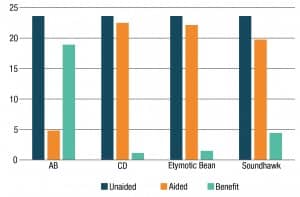
Figure 2. The average unaided (dark blue bars), aided (orange bars), and relative benefit (light blue bars) scores for the QuickSIN for these six cases, reflected by the means for the QuickSIN measure for the six individuals. QuickSIN benefit (in light blue) is the difference between the unaided and aided scores.
It should be noted that no subject was willing to try the CD model programmed hearing aids or the two PSAPs outside of the test environment, as all are working professionals who reported they depend on optimized hearing to perform in their respective professions. These adult subjects with moderate hearing loss considered AB real-ear programming essential to their function in any communication setting.
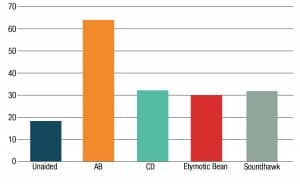
Figure 3. Mean Speech Intelligibility Index (SII) values (x 100) for the group: AB aided (orange bar), Humes CD (light blue bar), Etymotic Bean (red bar), and Soundhawk (gray bar) are provided.
Figure 3 shows the average better ear aided Speech Intelligibility Index (SII) values for the two PSAPs and the two different configurations of the ReSound Alera hearing aids (AB, CD), as well as the better ear unaided SII values per ANSI 1997 (R 2017).36 It is apparent that AB service delivery produced more average aided audibility of speech cues across these six cases. The significance of this difference in aided audibility is discussed below, as are the implications for most—if not all—subjects with similar moderate hearing losses.
Are PSAPs and OTC Devices a Good Solution for Moderate Hearing Loss?
The purpose of this study was to present six examples of individuals with moderate hearing loss fitted to current technology options, and to assess if results for speech recognition in noise differ from the data of Humes et al10 and Reed et al12 In part, this report is provided in response to actions taken by the FDA as well as the recent discussions and ensuing legislation which moves patients closer to a time where self-diagnosis and self-treatment of mild-to-moderate hearing loss with OTC hearing aids is possible. The data in this study indicate that the PSAPs and/or Consumer Decides models of delivery may not be appropriate for people with a more moderate degree of hearing loss due to the resultant limited audibility.
This study, which evaluated aided performance on six individuals with moderate hearing loss, is limited in its generalization to all patients with moderate hearing loss. It should be apparent, however, that any subject with a similar moderate hearing loss would have limited functional hearing, with an aided SII in the range reported in this study. Specifically, the highest average aided SII obtained was .32 in both the CD and PSAP conditions.
Although labeling on OTC devices are expected to include warnings against their use for children, there are no guarantees that parents will not place these questionably adequate devices on their children with moderate or more severe hearing loss. This is of concern, as research by Stiles et al37 indicate aided SII strongly correlates with a hard-of-hearing child’s ability to acquire and learn words, meaning, and language. Walker and McCreery38 have shown that, when poor aided audibility and inconsistent wearing schedules occur for children with hearing loss, their “global development” significantly suffers. Thus, the intentions of FDA and the OTC hearing aid law could potentially result in these devices/services being provided to children with hearing loss who possibly have treatable middle ear pathologies and/or may show little benefit from such methodologies.
Without professional oversight there is also no protection for adults with middle ear pathologies, Meniere’s disease, vestibular schwannoma, benign paroxysmal positional vertigo (BPPV), fall risk, impacted cerumen, otitis externa, otitis media, precancerous lesions on the pinna, and a host of other medical problems requiring further examination. Leavitt (in press) reports on the occurrence of the disorders noted above in a typical clinic population of the first 50 patients who came to the clinic after the NASEM recommendations were released. In this group, over 50% presented with one or more of the disorders noted above. While a cost-effective service delivery model should be considered, that model must provide for individualizing rather than a one-size-fits-all approach to hearing health care.
It is noteworthy that Humes et al state, “For the devices used in this project—good-quality devices with multiple channel compression, feedback cancellation, noise reduction, and directional microphones—the production costs were about $100/aid at study onset. Extremely high-volume dispensers of these devices, such as Costco and the Veterans Administration, were charged by the manufacturer about $250–$500 per aid at that time.”10 In 2016, VA and Costco hearing aid purchases accounted for an estimated combined total of 31.3% of all hearing aid sales in the United States in 2017.39 With that purchasing power these organizations obtain premium “good-quality” hearing aids at prices lower than the PSAPs recommended by Reed et al.12 If private practitioners (who dispensed 68.7% of all hearing aids sold in the United States in 2017) received such bulk purchasing discounts, they could obtain premium hearing aids obtained at bulk purchase prices under $250-$500 per unit. Further, unlike the CD model of Humes et al and the PSAPs identified by Reed et al, the “good-quality” hearing aids (appropriately programmed) in this study are appropriate for these six individuals with moderate hearing losses and allow all six to function in their chosen professions.
If the goals of the OTC service delivery model described by Humes et al and the PSAPs recommended by Reed et al are, as stated by NASEM, “[To] enable consumers to find and fully use the appropriate, affordable, and high-quality services, technologies, and supports they need,”5 neither the OTC service-delivery model as described by Humes et al or the PSAPs recommended by Reed et al achieved this goal for these six adult subjects with moderate hearing losses. Further, had the Resound Alera 961 hearing aids used in this study been provided to the audiologist at a price of $250-$500 per unit, the cost to the consumer would be well below the $2,500 per unit figure quoted by Reed et al, and would allow these six subjects to function in their chosen professions.
Conclusion
This series of six case studies shows that individuals with moderate hearing loss may be most advantageously served by an Audiology Best Practices service delivery model. The recent OTC legislation and ensuing deliberations with regard to FDA regulations and definitions for an OTC hearing device have made frequent use of the Humes et al and Reed et al data. Although both studies are useful and instructive, the results from our research suggest that caution is warranted in extending the consumer-driven care model to moderate losses (ie, 41-55 dB PTA). Specifically, our study suggests that without the probe-microphone verification of appropriate speech output, these individuals may end up with less-than-optimal aided audibility needed to function in their everyday settings.
Given these findings and continuing research showing correlations among hearing loss and dementia, increased risk of hospitalization, increased risk of falls, accelerated brain shrinkage, depression, and brain resource reallocation resulting from untreated and improperly treated hearing loss, it would appear that the use of a consumer-driven care model for people with moderate hearing loss requires further research and careful consideration before implementation.
References
-
Lin FR. Hearing loss and aging: Consequences, implications, and creating better outcomes through alternative models of care. Paper presented at the Academy of Dispensing Audiologists annual convention, Las Vegas, Nev;2014.
-
Lin FR. Hearing loss in older adults–A public health perspective. Paper presented at the National Center for Rehabilitative Auditory Research 7th Biennial Conference “Hearing Loss as a Public Health Concern”, Portland, Ore: September 16-18, 2015.
-
PCAST recommends creation of “basic” OTC hearing aid category; Easing of PSAP regulations. October 23, 2015. Available at: https://hearingreview.com/2015/10/pcast-report-hearing-loss-raises-concerns/
-
President’s Council of Advisors on Science and Technology (PCAST). Aging America & Hearing Loss: Imperative of Improved Hearing Technologies. October 26, 2015. Available at: https://obamawhitehouse.archives.gov/sites/default/files/microsites/ostp/PCAST/pcast_hearing_tech_letterreport_final.pdf
-
National Academies of Sciences, Engineering and Medicine (NASEM). Hearing Health Care for Adults: Priorities for Improving Access and Affordability. Washington, DC: The National Academies Press;June 2, 2016.
-
NASEM Committee Looks at Regulations for OTC Hearing Devices. June 14, 2017. Available at: https://hearingreview.com/2017/06/nasem-committee-looks-regulations-otc-hearing-devices/
-
HLAA Announces Support for Over-the-Counter Hearing Aid Act of 2017. June 16, 2017. Available at: https://hearingreview.com/2017/06/hlaa-announces-support-counter-hearing-aid-act-2017
-
ADA Announces Its Support of OTC Hearing Aid Act of 2016. December 8, 2016. Available at: https://hearingreview.com/2016/12/ada-announces-support-otc-hearing-aid-act-2016
-
Czuhajewski S, Spoor ADD. Academy of Doctors of Audiology (ADA) and over-the-counter hearing aids. Available at: https://www.hearingloss.org/wp-content/uploads/ADA-20170512.pdf
-
Humes LE, Rogers SE, Quigley TM, Main AK, Kinney DL, Herring C. The effects of service-delivery model and purchase price on hearing-aid outcomes in older adults: A randomized double-blind placebo-controlled clinical trial. Am J Audiol. 2017;26(1):53-79.
-
Humes LE, Rogers SE, Quigley TM, Main AK, Kinney DL, Herring C. The effectiveness of two service-delivery models in older adults: A randomized double-blind placebo-controlled clinical trial. Hearing Review. 2017;24(5);12-19. Available at: https://hearingreview.com/2017/05/effectiveness-hearing-aids-two-service-delivery-models-older-adults-randomized-double-blind-placebo-controlled-clinical-trial/
-
Reed NS, Betz J. Kendig N, Korczak M, Lin FR. Personal sound amplification products vs a conventional hearing aid for speech understanding in noise. J Am Med Assn. 2017;318(1), 89-90.
-
President Trump signs OTC hearing aid legislation into law. August 19, 2017. Available at: https://hearingreview.com/2017/08/president-trump-signs-otc-hearing-aid-legislation-law/
-
Warren E, Grassley C. S.670-115th Congress (2017-2018): Over-the-Counter Hearing Aid Act of 2017. August 2017. Available at: https://www.congress.gov/bill/115th-congress/senate-bill/670
-
FDA eliminates ‘physician waiver’ system in hearing aid dispensing. December 7, 2016. Available at: https://hearingreview.com/2016/12/fda-eliminates-waiver-system-patients-obtain-hearing-aids
-
Lin FR, Ferrucci L, Metter EJ, An, Y, Zonderman AB, Resnick SM. Hearing loss and cognition in the Baltimore Longitudinal Study of Aging. Neuropsychol. 2011;25(6):763-770. doi:10.1037/a0024238
-
Lin FR, Metter EJ, O’Brien RJ, Resnick, SM, Zonderman AB, Ferrucci L. Hearing loss and incident dementia. Arch Neurol. 2011;68(2):214-220. doi:10.1001/archneurol.2010.362
-
Lin FR, Yaffe K, Xia J, Xue Q, Harris T, Purchase-Helzner E, Satterfield S, Ayonayon HN, Ferrucci L, Simonsick EM [for the Health ABC Study]. Hearing loss and cognitive decline in older adults. JAMA Internal Med. 2013;173(4):293-299.
-
Lin FR, Albert M. Hearing loss and dementia–who’s listening? Aging Mental Health. 2014;18(6):671-673. doi:10.1080/13607863.2014.915924
-
Campbell J, Sharma A. Compensatory changes in cortical resource allocation in adults with hearing loss. Frontiers Systems Neurosci. 2013 Oct 25;7:71. doi:10.3389/fnsys.2013.00071
-
Campbell J, Sharma A. Cross-modal re-organization in adults with early stage hearing loss. PLoS ONE 2014;9(2):e90594. Available at: https://journals.plos.org/plosone/article?id=10.1371/journal.pone.0090594
-
Glick H, Sharma A. Cross-modal plasticity in developmental and age-related hearing loss: Clinical implications. Hear Res. 2017;343:191-201. Available at: https://doi.org/10.1371/journal.pone.0090594
-
Sharma A, Glick H. Cross-modal re-organization in clinical populations with hearing loss. Brain Sci. 2016;6(1)[Jan 26]. pii: E4. doi: 10.3390/brainsci6010004.
-
Sharma A, Glick H. Cortical neuroplasticity in hearing loss: Why it matters in clinical decision-making for children and adults. Hearing Review. 2018;25(7):20-24. Available at: https://hearingreview.com/2018/06/cortical-neuroplasticity-hearing-loss-matters-clinical-decision-making-children-adults/
-
Tecca JE. A perspective on the Indiana University OTC outcome study. Hearing Review. 2017;24(7):18-24. Available at: https://hearingreview.com/2017/06/perspective-indiana-university-otc-outcome-study/
-
Humes L. Larry Humes responds to “A perspective on the Indiana University OTC outcome study.” Available at: https://hearingreview.com/2017/07/letters-larry-humes-responds-perspective-indiana-university-otc-outcome-study
-
Clark JG. Uses and abuses of hearing loss classification. ASHA. 1981;July:493-500. Available at: https://www.researchgate.net/publication/16145943_Uses_and_abuses_of_hearing_loss_classification
-
Spahr AJ, Dorman MF, Litvak LM, Van Wie S, Gifford RH, Loizou PC, Loiselle LM, Oakes T, Cook S. Development and validation of the AzBio sentence lists. Ear Hear. 2012;33(1)[Jan/Feb]:112-117.
-
Hirsh IJ, Davis H, Silverman SR, Reynolds EG, Eldert E, Benson RW. Development of materials for speech audiometry. J Sp Hear Dis. 1952;17(3):321. doi:10.1044/jshd.1703.321
-
Department of Veterans Affairs. Speech recognition and identification materials, disc 4.0. Mountain Home, Tenn: VA Medical Center;2006.
-
Cox R, Alexander G, Taylor I, Gray G. The contour test of loudness perception. Ear Hear. 1997;18(5):388-400.
-
Olsen W, Noffsinger D. Comparison of one new and three old tests of auditory adaptation. Arch Otol. 1974;99:94-99.
-
Keidser G, Dillon H, Flax M, Ching T, Brewer S. The NAL-NL2 prescription procedure. Audiol Res. 2011;1(1S). doi:10.4081/audiores.2011.e24
-
Killion MC, Niquette PA, Gudmundsen GI, Revit LJ. Banerjee S. Development of a quick speech-in-noise test for measuring signal-to-noise ratio loss in normal-hearing and hearing-impaired listeners. J Acoust Soc Am. 2004;116(4):2395-2405. doi:10.1121/1.1784440
-
McArdle RA, Wilson RH. Homogenity of the 18 QuickSIN™ lists. J Am Acad Audiol. 2006;17:157-167. Available at: https://www.audiology.org/sites/default/files/journal/JAAA_17_03_01.pdf
-
American National Standards Institute (ANSI). ANSI/ASA S3.5-1997 (R2017). Methods For Calculation of the Speech Intelligibility Index. Washington, DC: ANSI. Available at: https://webstore.ansi.org/Standards/ASA/ANSIASAS31997R2017
-
Stiles DJ, Bentler RA, McGregor KK. The speech intelligibility index and the pure-tone average as predictors of lexical ability in children fit with hearing aids. J Sp Lang Hear Res. 2012;55(3)[Jun]:764-778. doi:10.1044/1092-4388(2011/10-0264
-
Walker EA, McCreery RW. Effects of amplification on auditory development outcomes for children who are hard of hearing. Paper presented at: American Academy of Audiology AudiologyNOW Convention, San Antonio, Tex, March 2015.
-
Strom KE. Hearing aid sales increase by 3.4% in 2017. Hearing Review. 2018;25(2):6. Available at: https://hearingreview.com/2018/01/staff-standpoint-hearing-aid-sales-increase-3-4-2017
About the authors: Ron Leavitt, AuD, owns a practice in Corvalils, Ore, and is the Founder of the Oregon Assn for Better Hearing, a nonprofit consumer test group for hearing aid users; Ruth Bentler, PhD, is a Professor in the Department of Communication Sciences and Disorders at the University of Iowa, Iowa City; and Carol Flexer, PhD, is a Distinguished Professor of Audiology at the University of Akron.
CORRESPONDENCE can be addressed to HR or Dr Leavitt at: [email protected]
Citation for this article: Leavitt R, Bentler R, Flexer C. Evaluating select personal sound amplifiers and a consumer-decision model for OTC amplification. Hearing Review. 2018;25(12)[Dec]:10-16.

